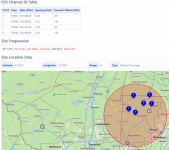In an effort to tune in on the other half of the UDP/TCP response packets, I'm attempting to tune in on the input frequency of my local repeater.
My understanding is that the P25 band plan specifies that the TX frequency is 45 MHz less than the RX frequency.
Since I normally tune in to the control channel at 853.6125 which lands me at 808.6125 for an input frequency.
Can anyone tell me if I'm on the right path?
Also, any idea if the input frequencies are repeated? (i.e. would I only be picking up troopers in close proximity to me, as opposed to their signals on 808Mhz being repeated to other towers on the site using the same input frequency)
Thanks in advance.
My understanding is that the P25 band plan specifies that the TX frequency is 45 MHz less than the RX frequency.
Since I normally tune in to the control channel at 853.6125 which lands me at 808.6125 for an input frequency.
Can anyone tell me if I'm on the right path?
Also, any idea if the input frequencies are repeated? (i.e. would I only be picking up troopers in close proximity to me, as opposed to their signals on 808Mhz being repeated to other towers on the site using the same input frequency)
Thanks in advance.


